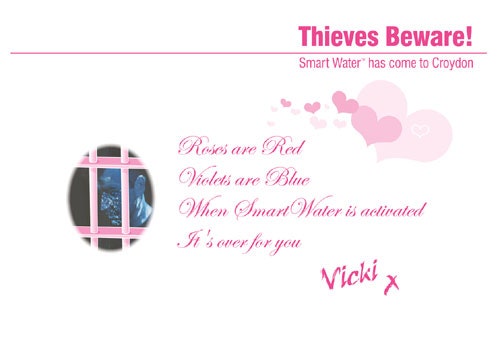
CARDIFF, Wales — Crooked criminal hearts may have fluttered and skipped a beat Monday when some of Britain’s most notorious thieves opened a valentine from an unwelcome secret admirer — one of London’s top female police chiefs.
But the greeting — in which Chief Superintendent Vicki Marr wrote “thinking of you and what you do” — was not so much an amorous expression to the underworld as part of a sting designed to catch hard-core burglars using new chemical microdot crime-fighting technology.
SmartWater is a clear liquid containing microscopic particles encoded with a unique forensic signature that, when found coated on stolen property, provides a precise trace back to the owner and, when detected on a suspect, can conclusively implicate a felon.
Likened to giving household items and vehicles a DNA of their own, the fluid is credited with helping cut burglary in Britain to a 10-year low, with some cities reporting drops of up to 85 percent.
A decade in the making, SmartWater is the name for a suite of forensic coding products. The first, Instant, is a property-marking fluid that, when brushed on items like office equipment or motorcycles, tags them with millions of tiny fragments, each etched with a unique SIN (SmartWater identification number) that is registered with the owner’s details on a national police database and is invisible until illuminated by police officers using ultraviolet light.
A second product, the Tracer, achieves a similar goal by varying the blend of chemical agents used in the liquid to produce one of a claimed 10 billion one-off binary sequences, encoded in fluid combinations themselves.

SmartWater CEO Phil Cleary, a retired senior detective, hit upon the idea after watching burglars he had apprehended walk free from court due to lack of evidence.
“It was born out of my frustration at arresting villains you knew full well had stolen property, but not being able to prove it,” he said.
“Just catching someone with hot goods, or a police officer’s gut belief a suspect is guilty, are not enough to secure a conviction — so we turned to science.”
Cleary is reluctant to discuss “trade secret” details of a product he has patented, but he concedes that, together with chemist brother Mike, he has developed “a mathematical model that allows us to generate millions of chemical signatures” — an identifier he boasts is “better than DNA.”
But more than property can get tagged. In spray form, the fluid marks intruders with a similarly unique code that, when viewed under UV in a police cell, makes a red-faced burglar glow with fluorescent green and yellow blotches. The resemblance to Swamp Thing and the forensic signature found on his body are telltale signs the suspect has been up to no good at a coded property.
“It’s practically impossible for a criminal to remove; it stays on skin and clothing for months,” Cleary added. “If a villain had stolen a watch, they might try to scrape off the fluid — but they would have to remove every last speck, which is unlikely.
“Sometimes burglars who know they are tagged with the liquid scrub themselves so hard behind the ears to get it off, police arresting them end up having to take them into hospital for skin complaints. But we don’t have much sympathy for them.”